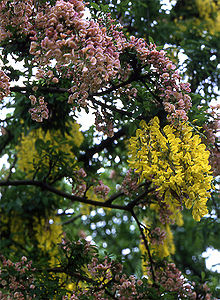Laburnocytisus
| +Laburnocytisus | |
|---|---|
 |
|
| +Laburnocytisus adamii has flowers typical of both laburnum and broom | |
| Scientific classification | |
| Kingdom: | Plantae |
| (unranked): | Angiosperms |
| (unranked): | Eudicots |
| (unranked): | Rosids |
| Order: | Fabales |
| Family: | Fabaceae |
| Subfamily: | Faboideae |
| Tribe: | Genisteae |
| Genus: | +Laburnocytisus |
| Binomial name | |
|
+Laburnocytisus adamii (Poit.) C.K.Schneid. |
|
| Cultivar | |
|
+Laburnocytisus 'Adamii' |
|
+Laburnocytisus 'Adamii'
+Laburnocytisus adamii (also known as Adam's laburnum or broom laburnum) is a horticultural curiosity; a small tree which is a graft-chimaera between two species, a laburnum, Laburnum anagyroides, and a broom, Chamaecytisus purpureus (syn. Cytisus purpureus), which bears some shoots typical of the one species, some of the other, and some which are a peculiar mixture of both "parents". This binomial name is written as if it were one species, but strictly speaking it is not one species but two. The plus sign (+) indicates its unusual origin. The plant can also be described by the formula Laburnum anagyroides + Chamaecytisus purpureus.
+Laburnocytisus adamii is a legume, a member of the pea family Faboideae (or Papilionaceae, formerly Leguminosae). Only one cultivar, 'Adamii' (formally designated as +Laburnocytisus 'Adamii'), is known to have arisen from this graft.
Most of the tree's branches resemble the laburnum in their foliage, which has three leaflets (3-palmate) and 3–6 cm long, yet also with dense clusters of broom-like shoots, also with three leaflets, but only 1 cm long and a darker green. It flowers in late spring or early summer; some branches have long (20–30 cm) racemes of yellow laburnum flowers, while others produce dense clusters of purple broom flowers. Remarkably, most branches will also produce coppery-pink flowers on short (8–15 cm) racemes, which are midway between the two "parents"; the leaves on these shoots are also intermediate. In older specimens, the proportion of broom and mixed tissues tends to decline, and the laburnum to predominate. The tree grows to a height of 7 m (rarely 8 m) and is hardy to USDA plant hardiness zone 5 in northern Europe. It requires moderately fertile, moist but well-drained soil and should be grown in a sunny position to flower well.
...
Wikipedia
